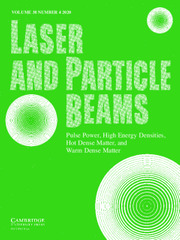Crossref Citations
This article has been cited by the following publications. This list is generated based on data provided by
Crossref.
Tallents, G J
2003.
The physics of soft x-ray lasers pumped by electron collisions in laser plasmas.
Journal of Physics D: Applied Physics,
Vol. 36,
Issue. 15,
p.
R259.
MOCEK, T.
SEBBAN, S.
BETTAIBI, I.
ZEITOUN, Ph.
FAIVRE, G.
CROS, B.
MAYNARD, G.
BUTLER, A.
McKENNA, C.M.
SPENCE, D.J.
GONSAVLES, A.J.
HOOKER, S.M.
VORONTSOV, V.
HALLOU, S.
FAJARDO, M.
KAZAMIAS, S.
LE PAPE, S.
MERCERE, P.
MORLENS, A.S.
VALENTIN, C.
and
BALCOU, Ph.
2005.
Progress in optical-field-ionization soft X-ray lasers at LOA.
Laser and Particle Beams,
Vol. 23,
Issue. 3,
p.
351.
Huang, H.
and
Tallents, G.J.
2006.
The output of amplified spontaneous emission lasers.
Journal of Quantitative Spectroscopy and Radiative Transfer,
Vol. 102,
Issue. 3,
p.
425.
CHYLA, W.T.
2006.
On generation of collimated high-power gamma beams.
Laser and Particle Beams,
Vol. 24,
Issue. 1,
p.
143.
Nejdl, J.
Kozlová, M.
Mocek, T.
and
Rus, B.
2010.
Measuring the electron density gradients of dense plasmas by deflectometry using short-wavelength probe.
Physics of Plasmas,
Vol. 17,
Issue. 12,
Nejdl, J.
Kozlová, M.
Mocek, T.
and
Rus, B.
2011.
X-Ray Lasers 2010.
Vol. 136,
Issue. ,
p.
281.
Kozlova, M.
Nejdl, J.
Krus, M.
Prokupek, J.
Dostal, J.
Rus, B.
Klisnick, A.
Meng, L.
Tissandier, F.
Stehlé, C.
Lefevre, R.
Chaulagain, U.
Champion, N.
Barroso, P.
Reix, F.
Jagourel, P.
Larour, J.
Delmotte, F.
Constancias, C.
Suzuki-Vidal, F.
and
Acef, O.
2014.
X-Ray Lasers 2012.
Vol. 147,
Issue. ,
p.
151.
Faenov, A.Ya.
Pikuz, T.A.
Magnitskiy, S.A.
Nagorskiy, N.
Tanaka, M.
Ishino, M.
Nishikino, M.
Kando, M.
Kodama, R.
Kato, Y.
and
Kawachi, T.
2016.
X-ray coherent mirage: Generation of phase – matched coherent point source in plasma media by propagated X-ray laser seeded beam.
Laser and Particle Beams,
Vol. 34,
Issue. 3,
p.
402.
Danson, Colin N.
White, Malcolm
Barr, John R. M.
Bett, Thomas
Blyth, Peter
Bowley, David
Brenner, Ceri
Collins, Robert J.
Croxford, Neal
Dangor, A. E. Bucker
Devereux, Laurence
Dyer, Peter E.
Dymoke-Bradshaw, Anthony
Edwards, Christopher B.
Ewart, Paul
Ferguson, Allister I.
Girkin, John M.
Hall, Denis R.
Hanna, David C.
Harris, Wayne
Hillier, David I.
Hooker, Christopher J.
Hooker, Simon M.
Hopps, Nicholas
Hull, Janet
Hunt, David
Jaroszynski, Dino A.
Kempenaars, Mark
Kessler, Helmut
Knight, Sir Peter L.
Knight, Steve
Knowles, Adrian
Lewis, Ciaran L. S.
Lipton, Ken S.
Littlechild, Abby
Littlechild, John
Maggs, Peter
Malcolm, Graeme P. A.
Mangles, Stuart P. D.
Martin, William
McKenna, Paul
Moore, Richard O.
Morrison, Clive
Najmudin, Zulfikar
Neely, David
New, Geoff H. C.
Norman, Michael J.
Paine, Ted
Parker, Anthony W.
Penman, Rory R.
Pert, Geoff J.
Pietraszewski, Chris
Randewich, Andrew
Rizvi, Nadeem H.
Seddon, Nigel
Sheng, Zheng-Ming
Slater, David
Smith, Roland A.
Spindloe, Christopher
Taylor, Roy
Thomas, Gary
Tisch, John W. G.
Wark, Justin S.
Webb, Colin
Wiggins, S. Mark
Willford, Dave
and
Winstone, Trevor
2021.
A history of high-power laser research and development in the United Kingdom.
High Power Laser Science and Engineering,
Vol. 9,
Issue. ,

